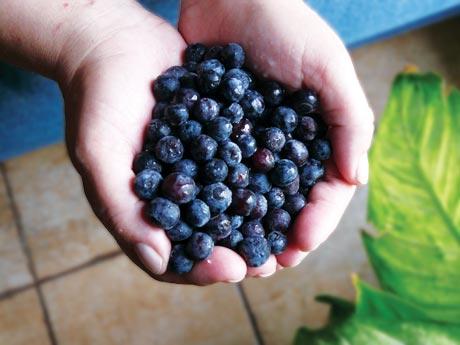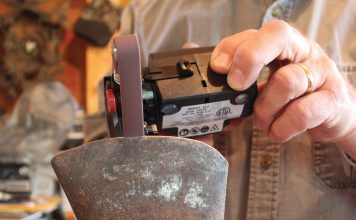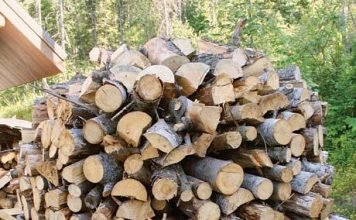| Issue #130 • July/August, 2011 |
My almost two-year-old grandson loves blueberries. Put a bowl of those round blue jewels in front of him, and he’s a happy little man. He’s not alone. Many folks love blueberries, whether they are used in whole wheat muffins, fresh in cereal, or over ice cream. Not only are blueberries delicious, but they also give us a number of health and nutrition benefits. They can be successfully grown in nearly every part of the country.
Blueberries freeze better than just about any other fruit or berry, so a summer crop of blueberries will continue to feed a family for months after being harvested.
One of the best things about growing blueberries is that they have proven, no matter where we have lived, to be our most reliable cash crop. In the Ozarks of Arkansas and Missouri ,where we lived and raised our kids, and way down south on the Gulf Coast, where we now reside, those little round blueberries have brought us some welcome cash income.
When I first planted my most recent berry patch, I just wanted some berries for our home use. We sure got that, and a lot more. From just a few dozen blueberry plants, I have picked several hundred dollars’ worth of cash-crop blueberries in the past five years. I have found that each year, I can sell every berry I don’t want to eat.
I don’t hesitate to say that blueberries should be on every small-farm grower’s list of cash crops to be considered.
|
Blueberries are easy
In the United States, there are basically three types of blueberries for the small-farm grower to consider: low-bush, high-bush, and rabbit-eye blueberries. Growers have used these native berries as the origins of the multitude of hybridized commercial blueberries.
Most blueberries used for home and commercial production are of the high-bush type because of the larger size of the fruit and the easier growth habits of the high-bush.
Small farm growers should do a bit of study before they run to the catalog to order a few acres of blueberry plants. It really does make a huge difference where in the country a farm is located as to the selection of blueberries to be grown. Small-farm owners should work closely with local university extension agents when selecting specific type of blueberries for a location. For instance, when I lived in the Ozarks, “Blueray” and a few other varieties did well. However, down here in the deep South where I now live, other varieties such as “Climax” do much better. It really is very important to do some study before planting. Time spent in determining the best variety of blueberry for a specific location can save a whole lot of time later.
It’s not too hard in most places in the United States to make blueberries happy. They like an acid soil, and they don’t like their roots to be wet. If these minimal requirements are met, blueberries will grow and produce. Most blueberries are quite cold resistant, and they don’t mind hot, humid weather such as we get on the Gulf Coast. There are varieties of blueberry which are very well suited to higher, mountainous climates.
In very dry places, some sort of irrigation will need to be anticipated. Drip systems seem to work very well with blueberries, and a low-rate drip system makes the best use of available water with minimal run-off or evaporation.
As mentioned earlier, blueberry plants are acid lovers, and they appreciate fairly heavy fertilizing with low pH fertilizers. Growers need to be careful not to over-apply nitrogen to blueberries; this can be quite harmful to the plants. Again, very good advice can be obtained from local extension agents. The state of Missouri, for instance, does a good job of getting good, useful information to blueberry growers.
Here’s the bottom line: make the plants happy and they will produce heavy crops for a long time with really minimal care and work on the part of the grower.
The first job for any potential berry grower is to determine how much time and space that can be devoted to a berry patch. If space and personal time is abundant, a grower may choose to plant several acres of blueberry bushes which will develop into a full-time job at least during growing and picking seasons. If time and space are limited (as in my present situation) a couple of dozen bushes planted in odd corners of the yard may be the extent of the blueberry growing. Either way, blueberries will reward the grower in most cases.
|
Blueberries as a cash crop
I will start my discussion of sales and money by stating from the outset that blueberries can, in certain cases, generate a good bit of money. The United States Department of Agriculture says that a mature planting of blueberries can return as much as $3,000 per acre with correct marketing, management, and growing.
Of course, the best choice for the small-farm grower with a good crop of blueberries is direct sales. Selling straight to the consumer by the grower generates the most cash. This is best accomplished by having a passer-by see the gorgeous, ripe, and shining berries in baskets and then sample a few. Cash changes hands, and everyone goes home very happy. Quite often, once local residents discover a berry grower’s prime, fresh product, word of mouth and repeat sales to individuals will consume the entire year’s production.
I have seen very large blueberry operations in the Midwest and deep South which relied almost entirely on “You-pick” procedures. This selling technique really requires minimal grower time in the field actually picking. It works like this: When the berries ripen, the field is opened up to visitors who come in and pick as many berries as they want. Gallon pails are provided by the growers, and folks come and pick until they get tired. When the picker is finished, he or she returns to the starting point and pays for the berries. This type of operation can be run on the “honor system” where the picker not only picks but measures and leaves payment in a secure drop-box or jar for the berries while the grower is elsewhere.
Many small farm growers use local farmer’s markets and flea markets to sell their berries, with very satisfactory results. I love to sell this way, and I’d sell all of my berries this way if possible. Unfortunately, I must work away from home, so my direct sales opportunities are limited to weekends.
Sometimes, dealing with a local fruit stand or produce market can be a very happy experience. I have sold most of my berries to local markets over the past five years, and by establishing myself as a reliable and conscientious grower who delivers product when promised, I know I have markets where I can sell every berry I grow.
For instance, Dennis Young, owner of Burris Fruit Market in Loxley, Alabama, who buys most of my excess blueberry production, gives potential home-farm growers some very good advice. “We need good, fresh, carefully picked and packaged berries,” he says.” We don’t want berries in gallon buckets we buy by pints only.” He recommends that growers check with the eventual seller to see what packaging size and form will be best. To help the grower out, most fruit markets will provide the grower with the desired containers for the product for no charge.
Young also advises home-growers to try to select varieties of berry which ripen and mature sooner than others. Berries which come ripe even a few days sooner than the main flood of produce will bring a higher price from fruit markets, so growers should try to grow early-ripening varieties. Again, check with local extension agents to determine which varieties will ripen sooner in a specific location.
When asked what the biggest benefit a fruit market offers small-farm berry grower’s, Young says it’s because markets buy in quantities. “I have a customer base which is very large. I provide a grower with a place to sell in bulk.”
|
There’s no reason not to go blue
I believe blueberries are just about the perfect fruit for small-farm growers who want to not only improve their personal and family nutrition, but also generate a little extra cash at the same time. Although the average small-farm owner probably won’t get rich selling blueberries, that little extra cash in summertime always seems to come at a good time at our house.
If properly planned, planted, and maintained, a blueberry patch will provide great benefits to the small-farm owner for many years to come. Spend a little time speaking with local university extension agents, walking over the property looking for good planting areas, and then plant good, suitable bushes. In just a few years, the berries and the cash will start rolling in.


















Thanks Lauri
Looks like no one is going to respond, Darlene, so I will chime in. We are blueberry farmers in the Pacific NW. Yes, blueberry bushes can be grown successfully in pots. The article only mentions three kinds, rabbit-eye, Southern Highbush, and Northern Highbush. All of these can be grown in large pots. The author doesn’t mention there are also hybrids that were developed specifically for growing in pots, like Top Hat. The production isn’t as great, but still decent. What the author does state, and other than keeping your soil at the right pH is the most important aspect of growing, is WHERE you live. Choose the TYPE of bush that grows in your region
Where we live (eastern Washington) there are few blueberry farms. The soil is very pH neutral and keeping it amended to the correct acidity level is very difficult. We currently have 4,000 bushes and growing but it’s a ton of work. Soil wants to go back to it’s original neutral state, and it seems to do that more readily in pots. Plant originally in peat moss and pine conditioner (pine mulch fines), or pine mulch mixed with some elemental sulphur. Top dress yearly with elemental sulphur to keep your pH down to 4.5-5.5. Weekly from April 1st through July 1st, mix 1 1/2 TBS Ammonium Sulphate with 2 1/2 gallons of water and water your potted bush with one gallon of that solution. That will not only provide enough of the nitrogen the bushes love, but the RIGHT kind of nitrogen. Water with regular water over the days in between. If you plant a high bush variety, and live in a hot and dry summer climate (like we do), make sure your potted bush gets about 5 gallons of water a week. Blueberries dont like to have their feet sitting in mush, but they do like moist soil and if in hot environments, get thirsty.
The 3rd most important aspect (other than variety and soil pH), is proper pruning. High bush and Rabbit Eyes require proper pruning for both health and good production. Top Hats dont need it.
Good luck!!!
Can blueberries be grown in pots or in planters? I love in town and everything has to be in pots or planters.